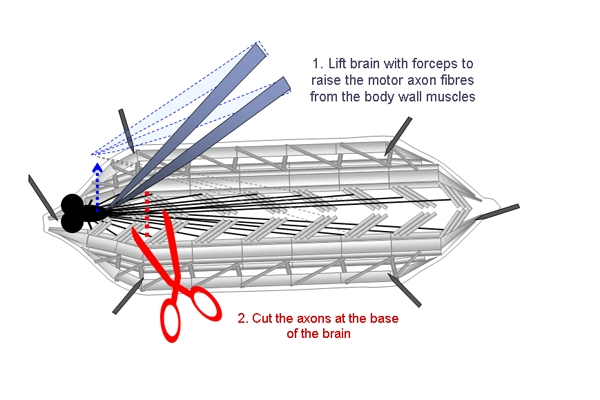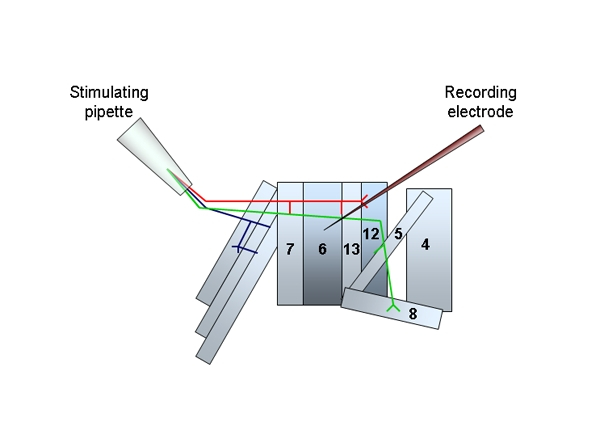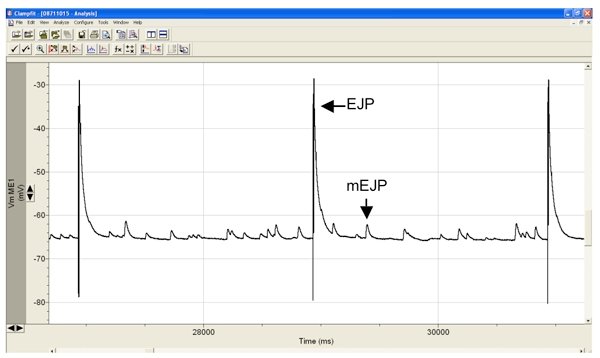Electrophysiological Methods for Recording Synaptic Potentials from the NMJ of Drosophila Larvae
Summary
Here we describe electrophysiological methods for measuring synaptic transmission at the neuromuscular junction of Drosophila larva. Evoked release is initiated artificially by stimulating the motor neuron axons, and transmission through the NMJ can be measured by the postsynaptic response evoked in the muscle.
Abstract
Protocol
Before starting prepare:
- Wandering yhird instar Drosophila larvae
- HL3.1 (Modified hemolymph-like) solution
- Sylgard (transparent silicone rubber) dissection plates prepared in small (35 x 10 mm) plastic petri dishes using methods described by Brent and McCabe (2008)3.
- Cut dissection pins short
- Stimulating electrode pipettes
- Sharp recording pipettes
HL3 Solution:
- During dissections and electrophysiological experiments, larva are immersed in HL3.1 solution2 that contains (in mM): 70 NaCl, 5 KCl, 4 MgCl2, 10 NaHCO3, 5 trehalose, 115 sucrose, and 5 HEPES, pH 7.2.
- Concentrations of CaCl2 are added to the HL3.1 solution to provide the required concentration of extracellular Ca2+.
- Larval dissections are performed at low Ca2+ concentrations (to avoid muscle contraction) using HL3.1 + 0.25 mM CaCl2, kept on ice.
- Electrophysiological experiments are typically recorded in HL3.1 + 1 mM CaCl2, but this can be adjusted from 0.4 – 1 mM Ca2+ as required.
- The HL3.1 solution is filter sterilized before use, and stored at 4˚C.
Preparation of stimulating and recording pipettes:
- Recording and stimulating pipettes are pulled with a Sutter P-2000 Laser based micropipette puller using the following settings: Heat = 390, Filament = 4, Velocity = 35, Delay = 200 and Pull = 0.
- Stimulating electrodes are prepared from thin-walled borosilicate glass capillaries with wide ends that were slightly bigger than the width of the severed motor axons. The shaped ends are firepolished to give a smooth finish (using a Narashiga pipette polisher), to minimize damage to the nerve. Stimulating electrodes are filled with bath solution (HL3.1 + 1 mM Ca2+).
- The recording electrodes are prepared from 1.2mm borosilicate glass, which is pulled to form a sharp pipette (30–60 mΩ), and filled with 3M KCl.
Part 1: Dissection of Drosophila Larvae
- Third instar wandering larvae are dissected to expose the muscles in the body wall as described previously4.
- Dissections are performed in HL3.1 + 0.25 mM Ca2+ on small silicone plates (35 x 10 mm). HL3.1 solution must be ice-cold for dissections in order to anaesthetize the larva, and is kept on ice before and during dissections.
- Larvae are dissected using methods described by Brent and McCabe (2008), that is modified for electrophysiology experiments by adding 0.25 mM Ca2+ to the HL3.1 dissection solution, and using short dissection pins (~2 mm in length) that are less likely to hit the microscope objective and electrodes during an experiment.
- Following dissection, the motor axons of the larvae are severed. This is done by gently holding the CNS and raising it slightly so the peripheral nerves that innervate the muscles posterior to the ventral ganglion can be cut without damaging the muscles (Figure 1). The brain is then removed.
- The dissected larval preparation is washed twice with HL3.1 + 1 mM Ca2+.

Figure 1. Schematic showing the steps involved in cutting the motor axons of dissected larvae. The CNS is lifted with forceps and the motor axons are cut at the base of the brain.
Part 2: Intracellular recordings from larval muscle cells.
- Place the dissection plate on the electrophysiology microscope and submerge the prep with HL3.1 + 1.5 mM Ca2+ and fix the bath electrode so it is in contact with the solution.
- All experiments are performed on muscle 6 within the third abdominal segment (A3). Peripheral nerves that innervate the muscles are stimulated using a suction electrode5.
- Position the stimulating electrode in the dish first to avoid vibrations when the intracellular electrode is in place. Place the stimulating electrode in close vicinity to the motor neuron innervating muscle 6 and apply gentle suction until the cut nerve is inside the glass pipette. Be careful not to stretch the nerves when suction is applied. Raise the pipette slightly so it is not touching the muscle and position it so it is not pulling on the cut nerve fibers (Figure 2).

Figure 2. A schematic of the musculature and innervating motor neurons of one abdominal segment from the Drosophila larva. The position of the stimulating pipette and severed nerves and the recording electrode in position at muscle 6 are illustrated. - Intracellular recordings are made with sharp microelectrodes filled with 3 M KCl. Position the recording electrode above the centre of muscle 6 on the third abdominal segment (A3) and adjust the input offset so it reads zero for the bath solution. Slowly lower the electrode and approach the muscle under high optical magnification until it touches the muscle surface. Watch the oscilloscope to confirm that the muscle has been penetrated. The resting membrane potential should be at least -60 mV, or the animal should not be used. Sporadic miniature endplate potentials should now be visible. Leave the cell to stabilize for one minute before starting to record.
- Changes in membrane potential are detected with an Axon HS-2A head stage and an Axoclamp 2B amplifier and recorded with Clampex v 8.2.0.235 (Axon Instruments). The Axoclamp 2B is interfaced to a computer that runs pCLAMP software and works in conjunction with the Digidata 1322A interface.
- Cells were recorded for 3 minutes without any stimuli to measure mEJP responses. Traces were analysed using Mini analysis software (Synaptosoft, v 6.0.3) and the mEJP amplitude and frequency determined.
Nerve Stimulation:
- The severed end of the motor neuron is stimulated with a series of square voltage pulses (0.3 ms duration) at an intensity that is sufficient for both motor axons, to evoke consistent responses in the whole muscle.
- The stimulus is generated with the Master-8 pulse generator, which is programmed to deliver pulses continuously according to the duration and interval times.
- Allow five seconds between stimuli for synaptic recovery at the NMJ.
- When determining the strength of the stimulus, begin with the lowest level and increase the intensity slowly over several trials. The minimum stimulus intensity that results in an evoked response should be used in experiments.
- When the appropriate stimulus intensity is reached, there should be one compound EJP and one muscle contraction evoked by the stimulus.
- Record at least 10 evoked potentials from each muscle and average the amplitudes.
Part 3: Representative Results

Figure 3. Representative intracellular recording from muscle 6 showing the evoked EJP’s is response to electrical stimulation of the segmental nerve, and the sporadic minature endplate potentials, or mEJP’s. EJP amplitudes in muscle 6 of healthy wild-type larvae, such as Canton S, are typically around 40 mV and the mEJP amplitudes between 1-3 mV.
Discussion
The methods described here provide a relatively quick and broad way to detect changes in synaptic function at the NMJ. The ability to perform electrophysiological recordings using intact animals in vivo, and perform genetic or pharmacological manipulations, make Drosophila an ideal animal model for investigating the physiological and genetic aspects of neurotransmission.
Since muscle cells are very large, some might prefer to add an additional step to this protocol for two electrode voltage clamp (TEVC) recording. This can be performed on the same larval preparation with the intracellular electrode in place, by positioning a current-passing electrode on the cell. Once the cell is sufficiently voltage clamped, the current response can be recorded.
Although muscle 6 is the most commonly used for electrophysiology recordings, muscles 7 and 12 can also be used.
The methods described here show the essentials of Drosophophila NMJ electrophysiology – techniques that were first described by Jan and Jan in 1976, and have since become the model system for researching synaptic physiology.
Materials
| Material Name | Type | Company | Catalogue Number | Comment |
|---|---|---|---|---|
| Small Petri dishes (35 x 10 mm) | Becton Dickinson | 1008 | ||
| SYLGARD 182 Silicone Elastomer Kit | Dow Corning Corporation | 3097366-1004 | ||
| Dissecting microscope | Carl Zeiss | 475002-9902 | ||
| Light for microscope | Schott | KLI500 | ||
| Dissection pins | Fine Science Tools | 26002-10 | ||
| pClamp 9 software | Axon CNS, Molecular Devices | PCLAMP 9 STANDARD | ||
| Dissection scissors: 3mm Vannas Spring Scissors | Fine Science Tools | 15000-0 | ||
| Dumont SS Forceps | Fine Science Tools | 11200-33 | ||
| Dumont #5 Forceps | Fine Science Tools | 11252-20 | ||
| Thin-walled borosilicate glass capillaries, with filament (1.0 mm, 4 in) | World Precision Instruments, Inc. | TW100F-4 | ||
| Borosilicate glass capillaries, with filament (1.2 mm, 4 in) | World Precision Instruments, Inc. | 1B120F-4 | ||
| Sutter P-2000 Laser Based Micropipette Puller | Sutter Instruments | Model P-2000 | ||
| Pipette polisher | Narishiga | MF-83 | ||
| Axon HS-2A head stage | Axon CNS, Molecular Devices | Model HS-2A | ||
| Micromanipulators | Sutter Instruments | MP-85 | ||
| Axoclamp 2B amplifier | Axon CNS, Molecular Devices | AXOCLAMP 2B | ||
| Clampex Software | Axon CNS, Molecular Devices | v 8.2.0.235 | ||
| Mini analysis software. v 6.0.3 | Synaptosoft | |||
| Brownlee Precision Amplifier | Brownlee | Model 410 | ||
| NaCl | Baker | 4058-01 | ||
| KCl | Sigma | p-9333 | ||
| NaHCO3 | Sigma | s6297-1kg | ||
| Trelahose | Sigma | TO167 | ||
| Sucrose | Fisher | bp220-212 | ||
| HEPES | Sigma | h-3375 | ||
| MgCl-6H2O | Sigma | m2670-1kg | ||
| CaCl2 | Fisher | c79-500 | ||
| Master-8 Pulse Generator | A.M.P.I | |||
| Vibration table for electrophysiology set up | Technical manufacturing corporation | |||
| Faraday Cage |
References
- Atwood, H. L., Govind, C. K., Wu, C. F. Differential ultrastructure of synaptic terminals on ventral longitudinal abdominal muscles in Drosophila larvae. J. Neurobiol. 24 (8), 1008-1024 (1993).
- Feng, Y., Ueda, A., Wu, C. F. A modified minimal hemolymph-like solution, HL3.1, for physiological recordings at the neuromuscular junctions of normal and mutant Drosophila larvae. J Neurogenet. 18 (2), 377-402 (2004).
- Estes, P. S., Roos, J., van der Bliek, A., Kelly, R. B., Krishnan, K. S., Ramaswami, M. Traffic of dynamin within individual Drosophila synaptic boutons relative to compartment-specific markers. J Neurosci. 16, 5443-5456 (1996).
- Brent, J. R., Werner, K. M., McCabe, B. D. Protocol for dissection of Drosophila larvae. J Vis Exp. , (2008).
- Jan, L. Y., Jan, Y. N. Properties of the larval neuromuscular junction in Drosophila melanogaster. J Physiol (Lond). 262, 189-214 (1976).
- Katz, L. C., Shatz, C. J. Synaptic activity and the construction of cortical circuits. Science. 274, 1133-1138 (1996).

